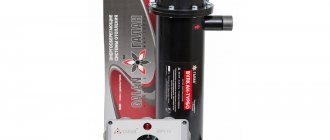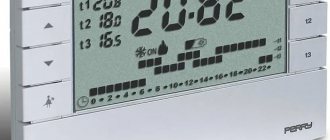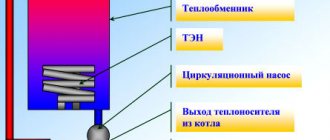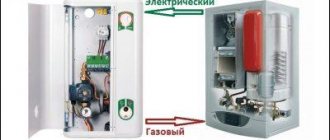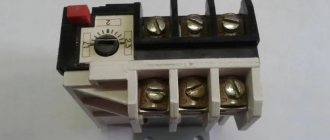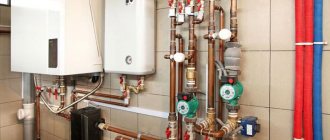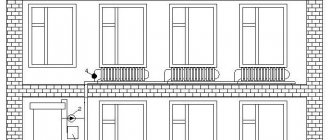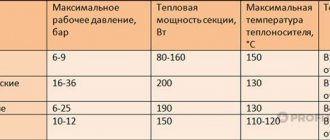Automatic temperature control in living and working spaces is a modern and effective means of saving energy resources and saving money on heating. The use of heaters and thermostats for them is especially important for owners of private houses in winter, because maintaining a certain temperature in the room is always more profitable than warming up the room when the temperature is below zero. We talk about the best models of thermostats for heaters, as well as how to choose them.
Automatic heat control system (SART)
TeleSystems LLC proposes the implementation of an automatic control system for heat consumption (SART) in order to ensure the rational use of thermal energy and create comfortable conditions for living and working.
Each of us has noticed more than once that during periods of warming, the radiators in the building remain as hot for a long time as in cold weather. Unfortunately, the centralized heating system in our country is characterized by inertia: correction of the coolant temperature at the heat source is carried out with a noticeable lag. Moreover, the centralized system is always focused on the average consumer, as a result of which in buildings located closer to the heat source, overestimated coolant parameters are always observed. In an effort to provide ourselves with comfortable living and working conditions, we open the windows, and the heat we pay for goes outside. And therefore, here lies the source of energy savings.
You can save on heat consumption by installing an automatic coolant temperature control system (CART) in the individual heating station of the building. It is designed to regulate heat consumption by increasing or decreasing the flow of coolant into the building, depending on its real needs at the moment.
Wide range and European quality
We offer a wide range of thermal heads for automatic control of thermostatic valves for your choice. Our catalog contains products from such well-known European companies as Danfoss, HEIMEIER, LUXOR, Meibes, RIFAR, STOUT, Watts.
For example, thermostatic elements produced by Danfoss (Denmark) are rightfully considered one of the best in terms of price/quality ratio. They are distinguished by their reliability and sophisticated design.
In our store, the prices for thermostats for radiators are very affordable. We have a wide range of thermal heads: gas, liquid, remote controlled, etc. We will always help you choose the best option for you. Contact us!
The main tasks of SART:
- Elimination of the supply of coolant to the facility with overestimated (“overheating”) and underestimated parameters, while the regulation of the coolant parameters depending on the outside air temperature occurs with minimal inertia - SART performs the correction instantly.
- Regulating the temperature of the coolant in the return pipeline of the heating network to eliminate the application of penalties by energy supply organizations for exceeding this temperature. SART allows you to limit the coolant intake from the network and re-enter it from the return pipeline into the heating system. And so on until his temperature reaches normal.
- Saving thermal energy by lowering the coolant temperature at night, as well as on weekends and holidays. For example, if a workshop operates in three shifts without days off, then this mode is not applicable, but if there is no staff in the workshop at night and on weekends (holidays), then it is possible to reduce the temperature of the coolant during this time.
- Maintaining a given temperature regime in the building using sensors located in control rooms. This will not save money, but will provide comfortable living and working conditions. The difficulty lies in selecting a control room for installing the sensor, taking into account that the temperature in it will affect the climate in the entire building. It is used, as a rule, for objects with a clearly defined control room, where it is necessary to ensure the greatest comfort with a variable schedule: cinemas, swimming pools, etc.
Also, the system developed by our specialists provides the technical ability to issue signals to a unified dispatch center when the regulated parameters go beyond the control limits. This significantly increases its reliability and minimizes the likelihood of system and equipment failure.
Benefits from implementing SART
The cost of creating a SART (design, installation and delivery to the ESO) by specialists of TeleSystems LLC, according to the price list, starts from 250 thousand rubles.
Our calculated average values of possible savings in thermal energy consumption using all algorithms of the SART module:
- application of weather control
16%, application of scheduled regulation
Total: total savings are about 38%.
In addition to savings and comfortable living conditions, the implementation of SART ensures balancing of the heating system, increases the service life of heating system equipment, increases the attractiveness of the house and ensures compliance with legislative requirements for energy saving.
Composition of the regulatory system
SART is a system of temperature sensors, a control valve, pumps, a controller and communication equipment (if remote control of the system is required). Using installed sensors, the temperature outside and inside the house, as well as the temperature in the supply and return pipelines, is analyzed. This data is transmitted to the control cabinet controller. The controller analyzes the sensor readings and issues a command to the control valve in accordance with a given schedule.
The control unit allows:
- set the temperature control mode for each day of the week, taking into account working and non-working hours;
- automatically maintain the specified mode for regulating the coolant supply;
- adjust the temperature regime and calendar when shifting working days and weekends;
- programmatically set the configuration of the heat control system from a set of standard schemes.
- facility supply line schedules;
- object return line schedules;
- hourly graphs of the regulator operating mode;
- normalized room temperature;
- standardized temperature at the boiler outlet;
- characteristics of valves and hydraulics; pump operating modes.
An automatic heat control system is installed on existing pipelines.
The cost of SART and its payback period are determined after the Customer fills out the questionnaire and processes it by the specialists of TeleSystems LLC. According to the experience of our company, residents’ investments pay off in 1 to 1.5 heating periods, while the service life of the equipment, if used correctly, is at least 15 years.
Our specialists have many years of experience in installing SART. We use reliable equipment from well-known manufacturers such as Danfoss, Wilo, Grundfoss, etc. Contact us and we will help you choose the best option for you. Preliminary examination is free.
Additionally, we recommend installing a module for commercial metering of consumed thermal energy in the heating station. Its installation will allow you to pay for real heat consumption, rather than calculated, and thus reduce heating costs.
Based on the experience of installing heat metering modules, the average savings during the heating season are:
- in residential brick buildings (taking into account the termination of payment for excess losses) - up to 40%;
- at social facilities (schools, kindergartens, hospitals, sanatoriums, etc.) - up to 40%;
- in residential panel buildings – up to 35%;
- in office buildings and administrative buildings – up to 25%;
- in industrial buildings (production workshops, warm warehouses, etc.) - up to 20%.
An integrated approach to energy saving
– Conducting energy surveys: from express surveys to in-depth energy surveys, from audits of products and technological processes to audits of a group of enterprises.
– Formation of energy saving programs both for an individual enterprise and for a region based on the results of energy surveys.
– Implementation of energy saving programs: from installing energy meters to renovating buildings.
A special place in the company’s product line is occupied by a number of complex products aimed at automating the accounting and management of energy resources based on the “Bee.Net” software developed by the company’s specialists.
© TeleSystems LLC Address: 620028, Ekaterinburg, st. Melnikova, 20 Tel./fax
Types of regulators
Setting the desired temperature in the refrigerator is easy. In order for each person to do this independently, manufacturers have provided a special mechanism.
According to the type of control, it is divided into 2 types: electronic and mechanical.
The electronic regulator can be recognized by the location of the display on the body of the refrigerator. Most often it is located on top of the door of the upper chamber, but it can also be located on the door. To set the required temperature, there are buttons near the display, or on expensive models it can be touch-sensitive.
The mechanical regulator is a rotary disk that can be turned up or down. Turning it clockwise makes the temperature in the refrigerator lower, and there are also numbers around the dial indicating the level of operation of the motor for cooling.
Choosing a heat control system with maximum efficiency
In accordance with the requirements of regulatory documentation and Federal Law No. 261 “On Energy Saving...”, the installation of automatic weather control systems should become the norm, both for new construction projects and for existing buildings, since this is the main tool for heat supply management. Today, such systems, contrary to popular belief, are quite accessible to most consumers. They are functional, highly reliable and allow you to optimize the process of thermal energy consumption. The payback period for the installation of equipment is within one year.
The automatic heat control system (SART) allows you to reduce thermal energy consumption due to the following factors:
- Elimination of excess thermal energy (overheating) entering the building;
- Decrease in air temperature at night;
- Decrease in air temperature on holidays.
Integrated indicators of thermal energy savings from the use of SART installed in an individual heating point (IHP) of a building are presented in Fig. No. 1.
Fig.1 Total savings reach 27% or more*
*according to NPP Elekom LLC
The main elements of classical SART are shown in general form in Fig. No. 2.
Fig.2 Basic elements of SART in ITP*
*auxiliary elements are not shown
Purpose of the weather controller:
- Measurement of outside air and coolant temperatures;
- Control of the KZR valve depending on the established regulation programs (schedules);
- Data exchange with the server.
Purpose of the mixing pump:
- Ensuring constant coolant flow in the heating system;
- Ensuring variable coolant mixing.
Purpose of the KZR valve:
control of the supply of coolant from the heating network.
Purpose of temperature sensors: measuring coolant and outside air temperatures.
- Differential pressure regulator. The regulator is designed to maintain a constant pressure drop of the coolant and eliminates the negative impact of an unstable pressure drop of the heating network on the operation of the SART. The absence of a differential pressure regulator can lead to unstable operation of the system, reducing the economic effect and service life of the equipment.
- Room temperature sensor. The sensor is designed to monitor indoor air temperature.
- Data collection and control server. The server is designed for remote monitoring of equipment performance and correction of heating schedules based on readings from indoor air temperature sensors.
The principle of operation of the classical SART scheme is qualitative regulation, complemented by quantitative regulation. Qualitative regulation is a change in the temperature of the coolant entering the heating system of the building, and quantitative regulation is a change in the amount of coolant coming from the heating network. This process occurs in such a way that the amount of coolant supplied from the heating network changes, but the amount of coolant circulating in the heating system remains constant. Thus, the hydraulic mode of the building’s heating system is maintained and the temperature of the coolant entering the heating devices changes. Keeping the hydraulic mode constant is a necessary condition for uniform heating of the building and efficient operation of the heating system.
Physically, the control process occurs like this: the weather controller, in accordance with the individual control programs embedded in it and depending on the current temperatures of the outside air and coolant, supplies control actions to the KZR valve. When in motion, the shut-off element of the KZR valve reduces or increases the flow of network water from the heating network through the supply pipeline to the mixing unit. At the same time, due to the pump in the mixing unit, a proportional selection of coolant is carried out from the return pipeline and mixed into the supply pipeline, which, while maintaining the hydraulics of the heating system (the amount of coolant in the heating system), leads to the required changes in the temperature of the coolant entering the heating radiators. The process of reducing the temperature of the incoming coolant reduces the amount of thermal energy that is taken per unit time from the heating radiators, which leads to savings.
SART diagrams in ITP of buildings from different manufacturers may differ slightly, but in all schemes the main elements are: weather controller, pump, KZR valve, temperature sensors.
I would like to note that in conditions of the economic crisis, an increasing number of potential customers are becoming price sensitive. Consumers are beginning to look for alternative options with the least amount of equipment and cost. Sometimes along the way there is a mistaken desire to save money by installing a mixing pump. This approach is not justified for SART installed in ITP buildings.
What happens if you don't install a pump? And the following will happen: as a result of the operation of the KZR valve, the hydraulic pressure drop and, accordingly, the amount of coolant in the heating system will constantly change, which will inevitably lead to uneven heating of the building, inefficient operation of heating devices and the risk of stopping the coolant circulation. In addition, at negative outside temperatures, the heating system may “defrost”.
It’s also not worth saving on the quality of the weather controller, because... Modern controllers allow you to select a valve control schedule that, while maintaining comfortable conditions inside the facility, allows you to obtain significant amounts of thermal energy savings. This includes such effective heat management programs as: eliminating overheating; reducing consumption at night and on non-working days; elimination of overestimation of return water temperature; protection against “defrosting” of the heating system; correction of heating schedules based on indoor air temperature.
To summarize the above, I would like to note the importance of a professional approach to the selection of equipment for a weather automatic control system for heat consumption in a building’s ITP and once again emphasize that the minimum sufficient basic elements of such a system are: a pump, a valve, a weather controller and temperature sensors.
23 years of work experience, ISO 9001 quality system, licenses and certificates for the production and repair of measuring instruments, SRO approvals (design, installation, energy audit), accreditation certificate in the field of ensuring uniformity of measurements and recommendations from clients, including government agencies, municipal administrations, large industrial enterprises allow the ELECOM company to implement high-tech solutions for energy saving and increasing energy efficiency with an optimal price/quality ratio.
What temperature should the refrigerator be?
Before you set the temperature control to a certain position, you need to understand how cold it should be in the refrigerator and freezer. The differences are related to the filling of the refrigerator - different types of products require different storage conditions:
- Meat, fish, eggs, hard cheese and sauces are best stored at a temperature of +1...+3ºС.
- Sausage, soft cheese and main courses require storage conditions at +2…+4ºС.
- It is optimal to store soups, boiled vegetables, bread and dairy products at +3…+5ºС.
- Seafood − +4…+6ºС.
- Fruits − +6…+8ºС. Some fruits are stored better not in the refrigerator, but in room conditions (for example, bananas and pineapple), this must be taken into account when placing fruits for storage.
Based on the optimal storage conditions for various products, the ideal temperature in the refrigerator is +3…+4ºС. In order for each type of product to be at the most comfortable temperature for storage, they should be placed in this way:
- The place with the highest temperature is the door - it is better to place juices, medicines and sauces here.
- It would be optimal to put vegetables, fruits and pickles in the boxes.
- The middle shelves of the refrigerator are the best place for soups, sauce and bread (+3...+5ºС).
- The place closest to the freezer is sausage, eggs, cakes (+2...+4ºС).
- It is better to place milk, cheese, meat, herbs and alcohol in the freshness zone (a little more than 0ºC).
At this temperature in the refrigerator, the number of degrees in the freezer can reach -30. This part of the unit is very helpful when you need to make long-standing supplies, but it is recommended to store frozen products for no longer than a month, otherwise they may lose their properties. Because The freezer provides long-term storage of food; it must be configured correctly. The number of degrees in the freezer depends on how much food it is filled with:
- For a small amount of food, -14ºС will be enough.
- When the chamber is very full and there is meat inside, you need to set the regulator to a lower temperature - -20...-24ºС.
- Ideally, the freezer should operate at -18ºС.
- If there is a need to urgently freeze food, you can set it to -30ºС, but it is better not to leave the freezer running like that for a long time, 2-4 hours is enough, otherwise the refrigerator motor will wear out.
Weather-compensated automation with shut-off valve and circulation pump.
And finally, the last type of automation for maintaining the temperature in apartments of residential buildings, depending on the temperature outside, is weather-dependent automation with a shut-off and control valve and a circulation pump.
Let's look at the principle of operation of this automatic temperature control system in an apartment, or rather, in an entire apartment building.
Here, temperature control in the heating system occurs by changing the valve capacity and, as in the previous scheme, mixing returned (return) network water from a residential building using a circulation pump, now installed on the return pipeline of the heating system. In principle, where the network or circulation pump will be installed is generally unimportant; it’s just that for a two-way valve such a scheme is still preferable due to its design features.
During the regulation process, the controller also periodically polls the coolant temperature sensors in the heating system of the house, indoor air sensors (if installed) and an outdoor air sensor. After processing the received information, the controller generates an output control signal to open or close the actuator of the two-way valve, and the value of opening or closing the flow area of the control valve changes accordingly. In the absence of an indoor air sensor, the main priority of regulation is also to maintain the temperature in the apartments according to the temperature schedule.
There is only one drawback of control schemes with valves - loss of electricity. For more information about the advantages and disadvantages of weather-dependent automation, see the article on weather control with a control elevator. The advantage of weather control schemes with valves over a control elevator is usually called the depth of regulation, although in our opinion such an advantage is controversial and can easily turn into a disadvantage if, for example, the ITP has a thermal energy metering unit, and its measurement limits are worse than the operating limits of automatic weather control. After installing automatic weather control without agreement with the energy supply organization, such a heating system can legally be recognized as non-commercial, which means that instead of saving, you will again receive payment for heat according to the standard.
- insufficient pressure at the inlet to the ITP, less than 0.07 mPa
- excessive resistance of the internal heating system of the house, more than 5 m.w.c.
- installation of automatic control valves on heating devices and risers, for example
- use of an independent heating system through heat exchangers.
I would also like to warn residents who are especially concerned about saving money that weather-compensated automation circuits with mixing valves cannot be used without a pump or with the pump turned off . In the operating mode with the pump turned off, the pumping of coolant through the heating devices sharply decreases; the difference in temperatures between the temperatures in the heating devices of different apartments sometimes reaches 45 degrees, instead of the twelve recommended for the economical mode of operation of weather-compensated automation. And most importantly, due to the lack of mixing in cold weather, the temperature in the heating devices of the first apartments along the route can reach 115 degrees or more, which will inevitably lead to the failure of modern polypropylene pipes , as well as burns from accidental touching of the heating devices - this is at a minimum. At the same time, the residents of the last apartments along the coolant path will sit in the cold.
This is the savings, and everything will be OK according to the instruments. And most importantly, if the check valve on the jumper between the direct and return pipelines fails, not only your home, but the entire area may be left without heat. The coolant will not go to the apartments, but will return back to the boiler room.
We examined possible options for schematic solutions for implementing weather-dependent automation in the control framework of multi-storey residential buildings. In any case, the decision to choose one or another weather-dependent temperature control scheme in the apartments of a residential building, and most importantly the selection of equipment, should be entrusted to specialists. You, as residents, should have your say only when choosing a design organization and the type of equipment - domestic or imported. The price depends on this.
All about the prices for design work, purchased equipment and installation and adjustment of automatic weather control in apartments of residential buildings on the next page.
Connecting a thermostat and outdoor temperature sensor to a gas boiler
The wires from the room thermostat - thermostat are connected to the terminal block marked as X17 (black in the figure on the left) in the 24 V compartment of the control panel of the Protherm Gepard (Panther) gas boiler.
The wires from the two-position thermostat are connected on the block to the RT terminals, instead of a jumper.
The wires from the Thermolink P interface thermostat are connected to the same block, but to the terminals marked “e-Bus”. The jumper between the RT terminals is left in place.
An outdoor temperature sensor can be connected to the Toext terminals.
Connecting a two-position wireless thermostat to the boiler - video
The wireless room thermostat consists of two blocks.
The executive unit is installed near the boiler and connected to the boiler by wires, to the same terminals as a conventional wired thermostat. To power the executive unit, it is also connected to a 220 volt power supply.
The measuring (control) unit with a display is mounted on the wall of a heated room. The signal from the measuring unit goes to the executive unit via a radio channel.
In order to install a heat saving system in your home, you need:
Application
Survey
Visit of a specialist to the site and commercial offer - free of charge
Agreement
We carry out major and current repairs
Project
We develop an individual project. Approval from supervisory authorities
Installation
In any season. Quality assurance. Right on time.
Commissioning
We carry out commissioning work. Setting the optimal heat consumption mode at home.
in the period from 2013 to 2022, existing heating units were retrofitted with weather-dependent automatic heating and maintaining the set hot water temperature. The heating and hot water systems are equipped with 2-circuit ART-05 regulators, control valves with electric drives and circulation pumps.
Apartment buildings, administrative and industrial buildings, as well as institutions of the Department of Culture of the Vladimir Region were retrofitted with weather-dependent automation.
The average monthly result of heat savings with proportional heating control was 20%. At the same time, the problem of uniform heating of heating devices throughout the house and the absence of overheating was solved.
By agreement with the customer, it is possible to establish a daily schedule for regulating the temperature of heating and hot water for additional savings and comfort for residents of the apartment building.
Raising the set temperature to heat the room faster
If you've just walked into a cold house on a freezing winter day, it might seem smart to turn the thermostat up. But this will not help you feel warmth and comfort faster. The reason for this is simple: the thermostat doesn't control how quickly your home heats up, all it does is set the final temperature for your comfort level. It's best to think of a basic thermostat as a temperature limiter. This allows the heat to be turned on completely until the set temperature is reached, at which point the thermostat will turn the heat off until the temperature drops again. So, if you turn the thermostat above the comfort level, the system will overheat the space, making your home too warm and wasting significant energy.
How to adjust (reconfigure)
All thermostats are factory adjusted. But their settings are standard and may not match your desired parameters. If you are not satisfied with something in the work - you want it to be warmer/colder, you can reconfigure the thermostat for the heating radiator. This must be done with the heating running. You will need a thermometer. You hang it at the point where you will control the state of the atmosphere.
- Close the doors, put the thermostat head in the extreme left position - completely open. The room temperature will begin to rise. When it becomes 5-6 degrees higher than what you want, turn the regulator all the way to the right.
- The radiator begins to cool down. When the temperature drops to a value that you consider comfortable, begin to slowly turn the knob to the right and listen. When you hear the coolant making noise and the radiator starting to warm up, stop. Remember what number is on the handle. It will need to be set to achieve the required temperature.
Adjusting the thermostat for a radiator is not difficult at all. And you can repeat this action several times, changing the settings.
Types of devices
Devices intended for control differ in design, but the principle of operation of the temperature controller is the same. They may involve mechanical, electronic components, or combinations thereof. There are currently 4 types of compact indoor appliances on the market:
- mechanical;
- electronic;
- programmers;
- wireless, radio controlled.
Models are used for underfloor heating systems, radiators, electric heaters and boilers.
Mechanical regulators
These are the simplest, practically trouble-free models. All settings are made manually. Thermostats designed for heating systems differ in the sensitive medium that is located inside the bellows. Therefore, mechanical devices on sale can be found in two types - liquid and gas-filled. The first devices are distinguished by their low price, the second - by greater reliability.
Gas-filled models have better speed and smoother response to temperature changes. Another advantage is the minimal influence of the coolant parameters on the gas environment of the thermostat bellows. Liquid regulators are characterized by greater precision in transmitting pressure to the rod.
The disadvantages of mechanical thermostats include:
- the need for manual configuration, it often requires adjustment;
- some inaccuracy of temperature indicators; the difference from the actual air or water temperature may be 4-5°.
The main advantage of such regulators is their reasonable price. Durability is the second plus, since in the simplest design there are practically no elements that can unexpectedly fail. Other models have a similar principle of operation of the temperature controller, but their equipment is more complex.
Electronic thermostats
These devices are more expensive, but they provide owners with the opportunity not to worry about constant monitoring of their operation. Such regulators provide settings with smooth changes in parameters at certain times of the day. They do not need any adjustment if the temperature outside the window increases or decreases.
All necessary indicators can be seen on the informative display. It can be push-button or touch-sensitive. For the convenience of owners, the kit includes a remote control. The disadvantages of the models are higher cost, risk of electronic failure.
Regulators-programmers
Programmable thermostats are quite expensive devices that have several modes and programs. But with their help, it is possible to constantly monitor the heating system, create the most comfortable microclimate, and configure it to save energy resources.
Analog devices have a Wi-Fi system that allows you to monitor and control work via a smartphone or tablet. However, for maximum convenience you will have to pay a large amount. Programmers have no other disadvantages, besides the possible failure of rather complex equipment.
Wireless models
A radio-controlled device (programmable thermostat) is perfection, because of which you will have to put up with the highest price of the device. But their big advantage is the absence of an electrical cable. Such equipment is intended for those owners who do not want to “spoil” the interior with either wires or additional sockets.
More often, a temperature controller is needed for a heating system, especially if it is the only or main source of heat. In this case, it is recommended to equip it with an electronic or programmable thermostat. Any device that has a heating sensor is suitable for auxiliary heating equipment.
Malfunctions
In some cases, the operation of the device is disrupted by air pockets. They can be eliminated by bleeding the air using a Mayevsky valve. A decrease in heat transfer results from blockage of the pipe passage with sediment or rust. To get rid of dirt, it is recommended to rinse the radiator with special products.
In centralized systems, the temperature of the coolant may decrease as a result of an emergency on the main pipeline or unauthorized actions of neighbors that caused a change in the flow parameters in the common riser. Circulation is worsened by a broken valve at the radiator inlet or an incorrectly installed plug.
Most likely it will be enough:
- release air;
- wash the battery from the inside;
- change the valve.
As a rule, after performing one or several actions, the previous heat transfer is restored.
How to adjust underfloor heating
If the house or apartment is not large, the region of residence is southern, heated floors can be left as the main source of heating. In other cases, it is made as a pleasant addition that will make life more comfortable. For example, in a children's room, in the bathroom or kitchen, in the work area. The thing is that you can’t make the floor very hot for obvious reasons. If it is minus 40 degrees outside, the heating system should be more powerful.
It is very convenient to have floors whose heating level is controlled. There are many devices for adjusting the temperature of a heated floor. Their work is based on a single principle.
Heating circuits are controlled individually through the installation of special manifolds that bring together the inputs and outputs of the heating system:
The temperature sensor for a water heated floor signals the thermostat that the temperature in the room (or on the floor surface) has increased. The chain includes a servo drive that controls the valves. Having received the appropriate signal from the thermostat, it admits a new batch of hot water into the system. Or, on the contrary, it will block its movement if the thermostat gives a signal that the room has become hot. The thermal valve for water heated floors helps regulate the flow of coolant. Such a thermostatic valve for underfloor heating allows you to effectively regulate the temperature of the coolant supply. A pump must be installed to pump water.
So, to control the temperature indicators of heated floors you need:
- a collector where all circuits are brought together;
- thermostat;
- temperature sensor;
- servo drive that controls the valves;
- pump for pumping water.
All this together makes it possible to make the heating system automated. This is not just convenience, but energy saving. Thermostats can be set so that in the absence of people the heating of the room will be reduced. Automatic machines allow you to save from 30 to 40 percent of energy resources. Moreover, this will not affect people’s living conditions; on the contrary, it will make staying in an apartment or house more comfortable.
In order to increase the safety of operation of devices, the installation of safety valves and protective fittings against voltage surges in the electrical network and overheating of electrical equipment is provided.
Complete heating shutdown
Many people turn off the heating completely when leaving the house. However, this can put your home at risk of damp, mold and, in extreme conditions, burst pipes. To prevent adverse complications in very cold weather, it is recommended to use a lower temperature. A lower temperature does not mean the heating is turned off when you are outside the home. If the set temperature is suitable for your home, the heating will be switched off while you're out for a normal period of time, but protected from dropping too much if you're out longer than expected.
What temperature should the main heating thermostats be set to?
Getting to the target temperature for your home can take some time and may require some experimentation, but a good starting point is 16 degrees. The average home takes approximately 1 hour to warm up from 16 to 21 degrees, so you should adjust your program accordingly. Smart thermostats can save you the hassle of experimentation by automatically calculating the optimal temperature for your home when you're away and turning on the heating to warm your rooms just in time for your arrival.
Is it possible to save on central heating fees?
Theoretically, the answer is yes, but in practice everything is not so simple. Let's assume that you decide to install a smart thermostat with programmable thermostats in your apartment. As a result of equipment operation, resource consumption will be reduced by about a third. This will also depend on the amount of heat loss from the home and other factors. But this fact will not affect the amount in the payment in any way.
The fact is that residents in apartment buildings pay for heating according to so-called standards or according to meter readings. The latter can be individual or communal. In our case, in order to register the fact of reduced resource consumption and, accordingly, reduce heating fees, you will need to install a heat meter in the apartment. This is not always possible.



